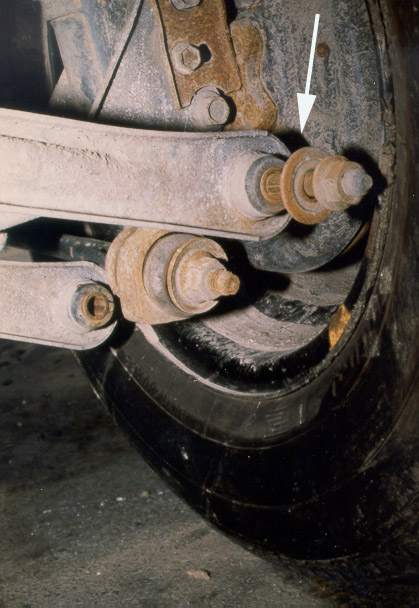
Figure 1

Figure 2
In Figure 2, a snowmobile steering ski bracket failed, causing
severe injury to the driver. The bolt had failed because of improper
bolt application.

Figure 3
In Figure 3, insufficient torque had been applied to an automotive
wheel stud, resulting in fretting of the wheel bolt hole area (black
deposit on the chrome wheel surface), failure of the wheel studs,
detachment of the wheel and an accident.
An important ingredient in the assessment of subrogation potential
from a bolt related accident is the recovery and preservation of the
failed bolt. In instances where the bolt fractured into two pieces,
recovery of both would be ideal, but one piece will show the
fracture surface which is the mirror image of the other. Figure 4 is
a typical bolt fracture surface showing a fracture origin area (red
arrow), ratchet mark (green arrow) indicating relatively high stress
or stress concentration and progression marks (blue arrow)
showing direction of crack advancement. These features are
utilized by the analyst to opine as to the probable cause of the
failure and should be preserved.

Figure 4
If subrogation is contemplated, then anticipating the action of the
respondent can help in planning an investigation. The typical
defense of choice is spoliation and a Daubert hearing long before
the merits of the case are discussed. Avoid the spoliation
argument with proper storage of the bolts and nuts. Each of the
individual failed bolt parts should be stored in separate packages to
avoid damage to fracture surfaces. Minimization of corrosion or
deterioration of the metallic surfaces during storage is
recommended. Get an agreement between parties as to a protocol
for nondestructive and destructive testing. Most microscopic
analysis is nondestructive but hardness testing, tensile testing and
chemical analysis are destructive. Avoid a Daubert hearing by
making sure that the failure analysis is performed in a scientifically
recognized manner with qualified analysts. Finally, the merits of a
bolt failure case may take several forms based on the failure
analysis and factual data. The bolt could be defectively
manufactured, defectively designed, improperly installed,
improperly torqued, or improperly selected for a particular
application.
BACK TO C. ROBERTS CONSULTING ENGINEERS HOME PAGE,
WWW.CROBERTS.COM

Figure 3
In Figure 3, insufficient torque had been applied to an automotive wheel stud, resulting in fretting of the wheel bolt hole area (black deposit on the chrome wheel surface), failure of the wheel studs, detachment of the wheel and an accident. An important ingredient in the assessment of subrogation potential from a bolt related accident is the recovery and preservation of the failed bolt. In instances where the bolt fractured into two pieces, recovery of both would be ideal, but one piece will show the fracture surface which is the mirror image of the other. Figure 4 is a typical bolt fracture surface showing a fracture origin area (red arrow), ratchet mark (green arrow) indicating relatively high stress or stress concentration and progression marks (blue arrow) showing direction of crack advancement. These features are utilized by the analyst to opine as to the probable cause of the failure and should be preserved.

Figure 4
If subrogation is contemplated, then anticipating the action of the
respondent can help in planning an investigation. The typical
defense of choice is spoliation and a Daubert hearing long before
the merits of the case are discussed. Avoid the spoliation
argument with proper storage of the bolts and nuts. Each of the
individual failed bolt parts should be stored in separate packages to
avoid damage to fracture surfaces. Minimization of corrosion or
deterioration of the metallic surfaces during storage is
recommended. Get an agreement between parties as to a protocol
for nondestructive and destructive testing. Most microscopic
analysis is nondestructive but hardness testing, tensile testing and
chemical analysis are destructive. Avoid a Daubert hearing by
making sure that the failure analysis is performed in a scientifically
recognized manner with qualified analysts. Finally, the merits of a
bolt failure case may take several forms based on the failure
analysis and factual data. The bolt could be defectively
manufactured, defectively designed, improperly installed,
improperly torqued, or improperly selected for a particular
application.
BACK TO C. ROBERTS CONSULTING ENGINEERS HOME PAGE,
WWW.CROBERTS.COM
BACK TO C. ROBERTS CONSULTING ENGINEERS HOME PAGE,
WWW.CROBERTS.COM
WWW.CROBERTS.COM